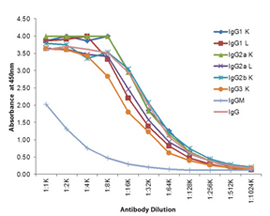Anti-Mouse IgG (gamma 1, 2a, 2b and 3 chain) (Phycoerythrin Conjugated) Secondary Antibody
Rabbit Polyclonal, R-Phycoerythrin (RPE)
- SPECIFICATION
- CITATIONS
- PROTOCOLS
- BACKGROUND
| Description | Anti-MOUSE IgG (gamma 1, 2a, 2b and 3 chain) (RABBIT) Antibody Phycoerythrin Conjugated |
|---|---|
| Host | Rabbit |
| Conjugate | R-Phycoerythrin (RPE) |
| Target Species | Mouse |
| Reactivity | Mouse |
| Clonality | Polyclonal |
Application
| IF, FC |
| Application Note | IF Microscopy 1:100-1:250 FlowCytometry 1:100-1:250 |
| Physical State | Lyophilized |
| Host Isotype | IgG |
| Target Isotype | IgG (gamma 1, 2a, 2b and 3 chain) |
| Buffer | 0.02 M Potassium Phosphate, 0.15 M Sodium Chloride, pH 7.2 |
| Immunogen | Anti-Mouse IgG subclass pan reactive Secondary Antibody was pproduced by repeated immunization with highly purified mouse IgG gamma 1, gamma 2a, gamma 2b and gamma 3 proteins |
| Reconstitution Volume | 1.0 mL |
| Reconstitution Buffer | Restore with deionized water (or equivalent) |
| Stabilizer | 10 mg/mL Bovine Serum Albumin (BSA) - Immunoglobulin and Protease free |
| Preservative | 0.01% (w/v) Sodium Azide |
| Shipping Condition | Ambient |
|---|---|
| Purity | Anti-Mouse IgG subclass pan reactive Secondary Antibody was prepared from monospecific antiserum by immunoaffinity chromatography using antigens coupled to agarose beads followed by solid phase adsorption(s) to remove any unwanted reactivities. This product shows balanced reactivity to Mouse IgG1, IgG2a, IgG2b and IgG3 proteins and is suitable to screen IgG class hybridoma clones. Minimal cross reactivity is observed against other Mouse immunoglobulin classes or light chain proteins. Coupling to R-PE was followed by size exclusion chromatography to purify conjugate from unreacted R-PE and antibody. Assay by immunoelectrophoresis resulted in a single precipitin arc against anti-Phycoerythrin, anti-Rabbit Serum, Mouse IgG and Mouse Serum. |
| Storage Condition | Store vial at 4° C prior to opening. Dilute only prior to immediate use. Do not freeze after reconstitution. Store reagent in the dark. This product is stable at 4° C as an undiluted liquid. Use subdued lighting during handling and incubation of cells prior to analysis. |
| Precautions Note | This product is for research use only and is not intended for therapeutic or diagnostic applications. |

Thousands of laboratories across the world have published research that depended on the performance of antibodies from Abcepta to advance their research. Check out links to articles that cite our products in major peer-reviewed journals, organized by research category.
info@abcepta.com, and receive a free "I Love Antibodies" mug.
Provided below are standard protocols that you may find useful for product applications.
Background
Anti-Mouse IgG subclass pan reactive Secondary Antibody Phycoerythrin Conjugated is ideal for investigators who routinely perform flow cytometry, immunohistochemistry or IHC and other immunoassays like western blotting.
If you have used an Abcepta product and would like to share how it has performed, please click on the "Submit Review" button and provide the requested information. Our staff will examine and post your review and contact you if needed.
If you have any additional inquiries please email technical services at tech@abcepta.com.













 Foundational characteristics of cancer include proliferation, angiogenesis, migration, evasion of apoptosis, and cellular immortality. Find key markers for these cellular processes and antibodies to detect them.
Foundational characteristics of cancer include proliferation, angiogenesis, migration, evasion of apoptosis, and cellular immortality. Find key markers for these cellular processes and antibodies to detect them. The SUMOplot™ Analysis Program predicts and scores sumoylation sites in your protein. SUMOylation is a post-translational modification involved in various cellular processes, such as nuclear-cytosolic transport, transcriptional regulation, apoptosis, protein stability, response to stress, and progression through the cell cycle.
The SUMOplot™ Analysis Program predicts and scores sumoylation sites in your protein. SUMOylation is a post-translational modification involved in various cellular processes, such as nuclear-cytosolic transport, transcriptional regulation, apoptosis, protein stability, response to stress, and progression through the cell cycle. The Autophagy Receptor Motif Plotter predicts and scores autophagy receptor binding sites in your protein. Identifying proteins connected to this pathway is critical to understanding the role of autophagy in physiological as well as pathological processes such as development, differentiation, neurodegenerative diseases, stress, infection, and cancer.
The Autophagy Receptor Motif Plotter predicts and scores autophagy receptor binding sites in your protein. Identifying proteins connected to this pathway is critical to understanding the role of autophagy in physiological as well as pathological processes such as development, differentiation, neurodegenerative diseases, stress, infection, and cancer.


